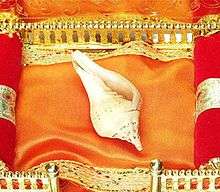Dakshinavarti Shankh

Dakshinavarti Shankh, Valampuri Sanggu; Tamil: வலம்புரி சங்கு or Sri Lakshmi Shankh, is a sacred Hindu object otherwise known in English as a conch shell. This is the shell of a large sea snail from the Indian Ocean (a shell of the species Turbinella pyrum), but one that has the very rare reverse-turning spiral.
In other words, when it is held with the spout (siphonal canal) pointed up, this conch's spiral twists rightwards (dakshinavarti) rather than very much more common form, which twists leftwards (vamavarti).[1][2]
True vs. fake
The genuine Lakshmi Shank is a sinistral conch shell from the Indian Ocean, and certainly not a (superficially similar) Sinistral Whelk (Lightning Whelk) species from Florida, USA. A true Valampuri shell is a species in the gastropod genus Turbinella L. The most common species is Turbinella pyrum L. It is important to note that only the rare sinistral variety of Turbinella species is a true Lakshmi Shankh. This kind of shell is very rare in its occurrence.
Other right-turning sea snail shells of a similar shape, such as the lightning whelk (Busycon perversum), are often mistakenly sold and worshiped in place of the genuine Shank. However, the real Lakshmi Shank has 3 to 7 ridges or plaits on its columella, whereas whelk shells does not show the presence of such plaits on its columella. The so-called "flower-bud opening test", and the "rice pulling test" (Valampuri said to rise up through a rice heap) are non scientific. The best authenticity test is to take an X-ray image of the Valampuri. Valampuries do show some morphological variation depending on origin, and shells with mixed characters of two adjacent localities are also seen.
In South India, people trust only the Rameshwaram type of Valampuries, and do not trust other varieties from West Coast and Bay of Bengal, though these are also the true Valampuries.
Origin
Genuine Dakshinavarti Lakshmi Conches are only found in the Indian Ocean, between Myanmar (Burma) all the way to Sri Lanka. There are three main localities of this shankh in India. Shells from all the localities show definite morphological variations. The three localities are the Indian Ocean near Ram Setu, Sri Lanka, Ramishwaram to Tuticorin. Shells from this region are rare in occurrence. The second locality is Arabian Sea or Western India. The third locality is Bay of Bengal. Varieties showing mixed characters have also been observed. The imitation (Lightning Whelks) mostly come from Florida and the Gulf of Mexico. This imitation is also known as African Valampuri. It is also important to note that other than Busycon species, few other species showing presence of folds in the cavity are wrongly mentioned as Dakshinavarti. These species though sinistral are different species. Having folds does not mean that they are all species under the genus Turbinella Linn.
Rarity
There are different varieties of Valampuri shells based on their locality. The three main localities are Rameshwar, Ram Setu, Sri Lanka. The second one is West Coast of India or Arabian Sea and third one is Bay of Bengal. All the three types show variation.
Real Lakshmi Conch (right side spinning) are estimated to occur only one per 100,000 conch shells. The shell of the lightning whelk on the other hand almost always opens on the right. Valampuries with five plaits or folds in its cavity are known as 'Panchajanya' and are very rare. Completely snow-white Valampuries are also very rare and expensive. Giant Valampuries more than 5 kg are extremely rare in occurrence. Valampuries more than 3 feet in length are reported.
Powers ascribed
The Lakshmi Conch is said to bring all manner of blessing, but particularly material wealth, upon the owner. Ritual use may include bathing deities, drinking from the conch, or the use of mantras oriented to goddess Lakshmi. It is a wonderful object for Vastu purpose giving high positive energy.
Current value
A true Valampuri / Dakshinavarthy shell may be sold on weight basis, but at the same times it can also be sold per piece. The present market cost in India falls in the range of Rs. 1100/- to Rs. 4.0500/- per gram. However, there have been some reports that pure milky white Ast Laxmi shell with 8 valeys and pink lines, is also sold up to Rs. 5000/- per gram. Based upon a market search, price was average of Indian Valampuri/ Dakshinavarthy depending on size, type, quality and Ignorance of Indian Buyers price can be much higher. Tiny dwarf Valampuries / Dakshinavarthy small enough to wear as a pendant are very rare and price is negotiable when available. Tiny Valampuri / Dakshinavarthy are practically not available and people are often being cheated by selling Sinistral Land Snail in the name of Tiny Valampuri / Dakshinavarthy.
It may be noted certain cartels working in Tamil Nadu and South India are creating an artificial shortage of Valampuri / Dakshinavarti Shells and are fooling common people by charging exorbitant prices, Customers are advised to lodge a complaints against them under MRTPC (Monopolies and Restrictive Trade Practices Commission) Act-1966.
Most of the sellers are also selling Lightning Welk or Busicon Contarium i.e. a shell from Florida and Bahamas, which is readily available in India for Rs. 100/- to Rs. 2000/- per piece in much much higher prices. Complains of forgery can also be initiated against them.
It is observed that many of the so-called dealers do not have the actual Valampuri / Dakshinavarthy pieces in hand. One can see pictures of the same Valampuri / Dakshinavarthy on different websites. Nobody knows, who has the actual piece available.
See also
References
- ↑ "Article on Valampuri - Weblink". Retrieved 2015-11-08.
- ↑ "Article on Valampuri - Weblink". Retrieved 2009-11-08.